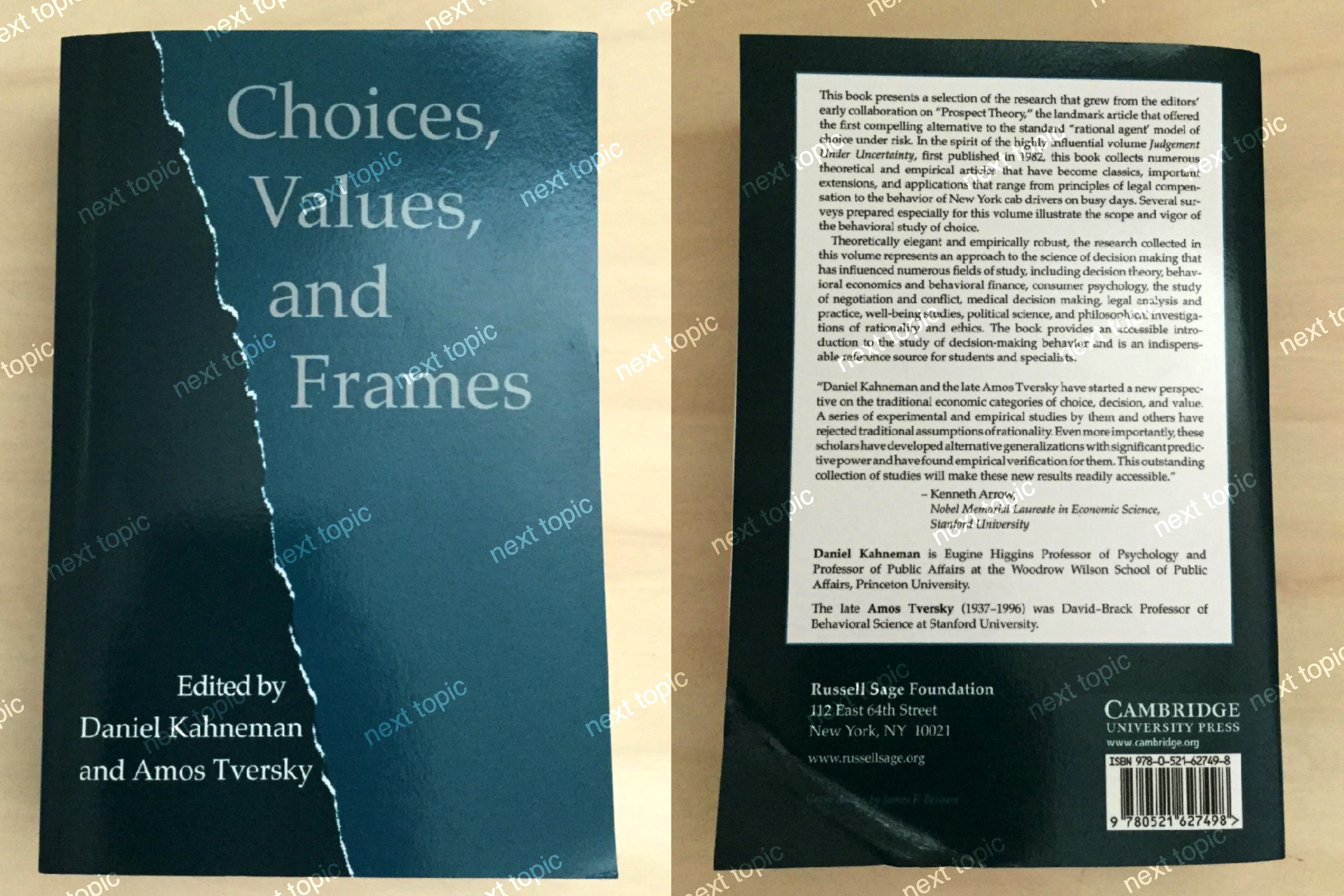ページコンテンツ
カーネマン論文集1
本書はカーネマンとトヴェルスキーによる編纂となり、行動経済、認知心理学における当時における最新ののその分野の進歩、特にプロスペクト理論に関連した傑出した解説です。こちらの編纂で提示された論文は、ノーベル賞を受賞した著者たちによる貢献が大きいです。(トベルスキーはノーベル賞を受け取る前に亡くなりました)。
一部の論文は、数学的知識を前提としますが、多くの数学を必要とする本の部分は、テキストの内容の多くを失うことなく理解できます。本書によって経済学で通常想定される合理的な経済理論の代替の最も信頼できる内容になります。消費者の行動に関連しているため、意思決定理論に興味がある場合よい読み物になります。

Choices, Values, and Frames
This book presents a selection of the research that grew from the editors’ early collaboration on “Prospect Theory,” the landmark article that offered the first compelling alternative to the standard “rational agent model of choice under risk. In the spirit of the highly influential volume Judgment Under Uncertainty, first published in 1982, this book collects theoretical and empirical articles that have become classics, important extensions, and applications that range from principles of legal compensation to the behavior of New York cab drivers on busy days.
Several surveys prepared especially for this volume illustrate the scope and vigor of the behavioral study of choice.Theoretically elegant and empirically robust, the research collected in this volume represents an approach to the science of decision making that has influenced numerous fields of study, including decision theory, behavioral economics and behavioral finance, consumer psychology, the study of negotiation and conflict, medical decision making, legal analysis and practice, well-being studies, political science, and philosophical investigations of rationality and ethics.
The book provides an accessible introduction to the study of decision-making behavior and is an indispensable reference source for students and specialists.
Daniel Kahneman and the late Amos Tversky have started a new perspective on the traditional economic categories of choice, decision, and value. A series of experimental and empirical studies by them and others have rejected traditional assumptions of rationality. Even more importantly, these scholars have developed alternative generalizations with significant predictive power and have found empirical verification for them. This outstanding collection of studies will make these new results readily accessible. Kenneth J. Arrow, Nobel Memorial Laureate in Economic Science,
Stanford University
Daniel Kahneman is Eugene Higgins Professor of Psychology and Professor of Public Affairs at the Woodrow Wilson School of Public Affairs, Princeton University.
The late Amos Tversky (1937-1996) was Davis-Brack Professor of Behavioral Science at Stanford University
CAMBRIDGE
UNIVERSITY PRESS
Contents
Preface List of Contributors
1 Choices, Values, and Frames
Daniel Kahneman and Amos Tversky
PART ONE. PROSPECT THEORY AND EXTENSIONS
2 Prospect Theory: An Analysis of Decision under Risk
Daniel Kahneman and Amos Tversky
3 Advances in Prospect Theory: Cumulative Representation
of Uncertainty Amos Tversky and Daniel Kahneman
PART TWO. THE UNCERTAINTY EFFECT AND THE WEIGHTING FUNCTION
4 Compound Invariant Weighting Functions in Prospect Theory
Dražen Prelec
5 Weighing Risk and Uncertainty
Amos Tversky and Craig R. Fox
6 A Belief-Based Account of Decision under Uncertainty
Craig R. Fox and Amos Tversky
PART THREE. LOSS AVERSION AND THE VALUE FUNCTION
7 Loss Aversion in Riskless Choice: A Reference-Dependent
Model
Amos Tversky and Daniel Kahneman
8 Anomalies: The Endowment Effect, Loss Aversion, and Status Quo Bias Daniel Kahneman, Jack L. Knetsch, and Richard H. Thaler
9 The Endowment Effect and Evidence of Nonreversible Indifference
Curves Jack L. Knetsch
10 A Test of the Theory of Reference-Dependent Preferences
lan Bateman, Alistair Munro, Bruce Rhodes, Chris Starmer, and Robert Sugden
11 Diminishing Marginal Utility of Wealth Cannot Explain Risk Aversion
Matthew Rabin
PART FOUR. FRAMING AND MENTAL ACCOUNTING
12 Rational Choice and the Framing of Decisions
Amos Tversky and Daniel Kahneman
13 Framing, Probability Distortions, and Insurance Decisions
Eric J. Johnson, John Hershey, Jacqueline Meszaros,and Howard Kunreuther
14 Mental Accounting Matters
Richard H. Thaler
PART FIVE. APPLICATIONS
15 Toward a Positive Theory of Consumer Choice
Richard H. Thaler
16 Prospect Theory in the Wild: Evidence from the Field
Colin F. Camerer
17 Myopic Loss Aversion and the Equity Premium Puzzle
Shlomo Benartzi and Richard H. Thaler
18 Fairness as a Constraint on Profit Seeking: Entitlements in the Market
Daniel Kahneman, Jack L. Knetsch, and Richard H. Thaler
19 Money Illusion
Eldar Shafir, Peter Diamond, and Amos Tversky
20 Labor Supply of New York City Cab Drivers: One Day at a Time
Colin F. Camerer, Linda Babcock, George Loewenstein,and Richard H. Thaler 21 Are Investors Reluctant to Realize Their Losses?
Terrance Odean
22 Timid Choices and Bold Forecasts: A Cognitive Perspective on Risk Taking
Daniel Kahneman and Dan Lovallo
23 Overconfidence and Excess Entry: An Experimental Approach
Colin F. Camerer and Dan Lovallo
24 Judicial Choice and Disparities between Measuresof Economic Values
David Cohen and Jack L. Knetsch
25Contrasting Rational and Psychological Analyses of Political Choice
George A. Quattrone and Amos Tversky
26 Conflict Resolution: A Cognitive Perspective
Daniel Kahneman and Amos Tversky
PART SIX. THE MULTIPLICITY OF VALUE: REVERSALS OF PREFERENCE
27 The Construction of Preference
Paul Slovic
28 Contingent Weighting in Judgment and Choice
Amos Tversky, Shmuel Sattath, and Paul Slovic
29 Context-Dependent Preferences
Amos Tversky and Itamar Simonson
30 Ambiguity Aversion and Comparative Ignorance
Craig R. Fox and Amos Tversky
31 Attribute Evaluability: Its Implications for Joint-Separate Evaluation Reversals and Beyond
Christopher K. Hsee
PART SEVEN.CHOICE OVER TIME
32 Preferences for Sequences of Outcomes
George F. Loewenstein and Dražen Prelec
33 Anomalies in Intertemporal Choice: Evidence and an Interpretation
George Loewenstein and Dražen Prelec
PART EIGHT. ALTERNATIVE CONCEPTIONS OF VALUE
34 Reason-Based Choice
Eldar Shafir, Itamar Simonson, and Amos Tversky
35 Value Elicitation: Is There Anything in there?
Baruch Fischhoff
36 Economic Preferences or Attitude Expressions?
An Analysis of Dollar Responses to Public Issues
Daniel Kahneman, Ilana Ritov, and David Schkade
PART NINE.EXPERIENCED UTILITY AND OBJECTIVE HAPPINESS
37 Experienced Utility and Objective Happiness: A Moment-Based Approach
Daniel Kahneman
38Evaluation by Moments: Past and Future
Daniel Kahneman
39Endowments and Contrast in Judgments of Well-Being
Amos Tversky and Dale Griffin
40 A Bias in the Prediction of Tastes
George Loewenstein and Daniel Adler
41 The Effect of Purchase Quantity and Timing on Variety-Seeking Behavior
Itamar Simonson
42 New Challenges to the Rationality Assumption
Daniel Kahneman
References
Author Index
Subject Index
Preface
This preface is not the one that Amos Tversky and I intended to write. Soon after Amos learned early in 1996 that he only had a few months to live, we decided to edit a joint book on decision making that would collect much of our work on this topic and congenial research by others. The collection was to be a sequel and companion to a volume on heuristics and biases of judgment that we had edited together with Paul Slovic many years earlier, and a substitute for a book that Amos and I had promised the Russell Sage Foundation.
Most of the editorial task was completed quickly, although some new pieces that Amos wanted to include – notably one that I was to write – were only completed long after he was gone. The problem of writing a preface was more difficult than finding articles we liked. Our initial aspirations for the preface were high; we were going to write a broad essay presenting a view of how the field had changed in the preceding 20 years. But we ran out of time before we had a presentable product. Amos advised me to “trust the model of me that is in your mind” and write for both of us.
This was not advice that I was able to follow: the risk of writing in his name statements that he might have rejected proved intimidating to the point of paralysis. I chose to take the smaller risk of writing on my own and in a more personal vein than we would have adopted if we had written jointly. My intent is to provide a perspective on some dominant themes of this book by tracing them to the years that we spent working closely together on the problem of choice.
Amos and I began to collaborate in the study of decision making in 1974, soon after completing a review of our earlier work on judgment, which appeared in Science that year. Because I had no expertise in the formal study of choice, in which he was already a star, Amos encouraged me to read the text on mathematical psychology that he had coauthored with his teacher Clyde Coombs and his contemporary Robyn Dawes. The most relevant chapter was concerned with preferences between gambles; it included an introduction to utility theory and an exposition of the Allais paradox.
Our discussions of this chapter quickly focused on a remarkable discrepancy: the theoretical analysis implied that the carriers of utility were states of wealth, but the outcomes of gambles were always described as gains and losses. Some extra assumption was clearly required to bridge the gap – either a spontaneous mental activity that transforms gains and losses into states of wealth, or a highly constrained correspondence between the psychophysics of wealth and the psychophysics of gains and losses. Neither hypothesis seemed appealing. This observation eventually led us to develop a theory of choice under risk that we called prospect theory (Chapter 2).
Our method of research in those early Jerusalem days was pure fun. We would meet every afternoon for several hours, which we spent inventing interesting pairs of gambles and observing our own intuitive preferences. If we agreed on the same choice, we provisionally assumed that it was characteristic of humankind and went on to investigate its theoretical implications, leaving serious verification for later. This unusual mode of empirical research enabled us to move quickly. In a few giddy months we raced through more than twenty diverse theoretical formulations. Among others, we considered a treatment of risky choice in terms of regret, but we eventually abandoned this approach because it did not elegantly accommodate the pattern of results that we labeled ‘reflection’: changing the signs of all outcomes in a gamble almost invariably changed the direction of preferences from risk averse to risk seeking or vice versa.
Prospect theory was nearly complete in the spring of 1975; it was then called value theory. A reader familiar with the final version would find almost all the important ideas in that early draft. However, the three additional years that we spent fine-tuning the theory turned out to be essential to its viability. The idea of editing operations, for example, was our answer to many potential counterexamples; it took three years to get to it. Amos was capable of infinite patience. His frequently repeated exhortation “let’s get it right” and the contagious pleasure that he found in the activity of thinking enabled us to persevere in the task of anticipating possible objections – even minor ones – long enough to ensure that they had been resolved, not papered over.
The theory that we constructed was as conservative as possible. We stayed within the decision theoretic framework in which choice between gambles is the model for all decisions. We did not challenge the philosophical analysis of choices in terms of beliefs and desires that underlies utility theory, nor did we question the normative models of rational choice offered by von Neumann and Morgenstern and later by Savage. The goal we set for ourselves was to assemble the minimal set of modifications of expected utility theory that would provide a descriptive account of everything we knew about a severely restricted class of decisions: choices between simple monetary gambles with objectively specified probabilities and at most two nonzero outcomes.
Without additional assumptions, prospect theory is not applicable to gambles that have a larger number of outcomes, to gambles on events, or to transactions other than choice; it does not even specify a selling price for monetary gambles. And our hopeful statement that “the extension of equations (1) and (2) to prospects with any number of outcomes is straightforward” (p. 74) turned out to be very optimistic. We got to it some thirteen years later (see Chapter 3), and the extension was not at all straightforward.
It is fair to ask, What is the point of investing so much effort in a theory if its domain of application is so restricted and artificial? The answer is that choice between gambles is the fruit fly of decision theory. It is a very simple case, which contains many essential elements of much larger problems. As with the fruit fly, we study gambles in the hope that the principles that govern the simple case will extend in recognizable form to complex situations. A theory of choice should therefore be evaluated by two distinct criteria, and a successful theory must satisfy both. One requirement is to “get it right” within a precisely specified domain. The theory should be refutable in that domain, and it should be unrefuted. The larger prize, however, lies elsewhere. The principles of the theory should provide a heuristic benefit in the analysis of more complex decisions, by suggesting hypotheses and by providing templates and labels for the identification of phenomena. For example, although it is surely futile to “test” prospect theory against utility theory in the domain of international relations, the concepts of loss aversion and pseudocertainty are useful tools for understanding strategic decisions. No warranty is implied, of course. The scholars who use the tools to explain more complex decisions do so at their own risk.
Many chapters in the present collection explore one or another of four themes that emerged from our attempt to construct a viable theory of our chosen domain. When we published prospect theory we had a clear view of only the first two of these ideas: the nonlinearity of decision weights and the referencedependent characteristics of the value function. The third theme, the significance of framing effects, was present in rudimentary form in that article and was articulated soon afterward. The fourth idea, the need to distinguish experienced utility from decision utility, came up early in our conversations but was only developed much later.
NONLINEAR DECISION WEIGHTS
The expectation principle of utility theory requires a linear response to variations of probability. As a descriptive generalization, this idea is transparently wrong: intuition suggests, and experiments readily confirm, that raising the probability of an outcome from .39 to 40 has much less impact on preferences than increasing the probability of the same outcome from 0 to .01 or from .99 to 1.00. This observation, which Ward Edwards and others had made before us, was incorporated in the decision weight function of prospect theory.
Several chapters of this book document the progress that was subsequently achieved in the understanding of decision weights. These include the rank dependent formulation that generalizes prospect theory to gambles with any number of outcomes (Chapter 3), Dražen Prelec’s novel analysis of the shape of decision weights (Chapter 4), and an important extension to the case of gambles on events, which sheds light on both the Ellsberg and the Allais paradoxes (Chapter 5). I believe that in his last year Amos was close to achieving a major generalization of prospect theory in a unified treatment of risk and uncertainty (Chapter 6).
With characteristic restraint, however, he rejected the suggestion to label this work “extended prospect theory.” Chapter 6 also illustrates an important observation that Amos and his students had analyzed in the context of support theory: the large influence of the “packing” or “unpacking” of events on subjective probabilities, and through them, on decision weights. To maintain unity of style Amos chose not to include in the present collection the results of the mathematical explorations of prospect theory to which he devoted a significant effort in the 1990s in a fruitful collaboration with Peter Wakker.
REFERENCE-DEPENDENCE AND LOSS AVERSION
Standard applications of utility theory assume that the outcomes of risky prospects are evaluated as states of wealth. This assumption was the cornerstone of the version of utility theory that Daniel Bernoulli offered in 1738, and it has been retained ever since. The proposition that the carriers of utility are states of wealth is accepted as a matter of course in economic analyses and in the prescriptions of decision analysts. However, casual observation suggests that this assumption must also be modified.
In the vernacular of decision making, financial outcomes are almost always described as gains and losses; states of wealth are rarely mentioned unless death or ruin is a possibility. The argument appears to have been closed by Matthew Rabin’s demonstration that no utility function for wealth can accommodate the extreme risk aversion that people exhibit when they face gambles with small stakes (Chapter 11).
The isolation effect described in prospect theory was intended as a direct experimental test of the hypothesis that preferences for gambles are determined by the utility of wealth. Respondents were asked to imagine that they had been given an unconditional gift of cash and that they now faced a choice between a sure outcome and a fair gamble. There were two versions of the problem with different combinations of the size of the gift and of the possible outcomes of the choice.
The options described in the two versions were strictly identical in terms of possible states of final wealth and their probabilities, but one of the choices was between a sure gain and a positive gamble; the other was between a sure loss and a negative gamble. As expected from the reflection effect, most respondents were risk averse in the first version, and most were risk seeking in the second-much as they would have been if the initial cash gift had not been mentioned at all. This demonstration simultaneously provided a counterexample to the idea that the carriers of utility are states of wealth and positive evidence for the role of gains and losses. It was also the first application of the method that we used later to study framing effects.
The idea that the effective carriers of utility are gains and losses was not new. Markowitz had proposed it much earlier. The distinctive contribution of prospect theory was the S-shaped value function that is reproduced in many articles in this collection. The convex-concave shape contributed to the explanation of the reflection effect, which we then considered our most remarkable experimental result. The value function is also much steeper in the domain of losses than in the domain of gains, a characteristic that we later labeled loss aversion. The assumption of loss aversion helped explain two salient facts of risky choice: the almost universal rejection of gambles that offer equal probabilities to win and lose the same amount, and the increase of this aversion with the size of the stakes. We introduced loss aversion reluctantly.
As we well knew, it is hardly elegant for a theory of choice to invoke different explanations of risk aversion for positive prospects and for prospects in which losses are possible, but we found no simpler model that would account for the facts. We realized only much later that loss aversion is the element of prospect theory that has the richest implications beyond its narrow domain.
We had considerable help from a friend in appreciating the broader significance of loss aversion. While we were still working on the final version of prospect theory, a young economist named Richard Thaler sought us out. Dick had begun a career of ironic and deep comments on his discipline while still a graduate student, collecting amusing anecdotal examples of everyday behaviors of consumers that violated basic assumptions of standard economic theory.
He realized (Chapter 15) that many of these anomalies could be explained by extending the idea of loss aversion to riskless decisions. The most important application was to the endowment effect, which Thaler illustrated by the memorable example of a bottle of old wine which the owner would refuse to sell for $200 but would not pay as much as $100 to replace. This pattern is odd in the context of standard economic theory in which an individual’s buying price and selling price for a good are assumed to differ only because of transaction costs and an income effect. In contrast, the endowment effect is readily explained by two assumptions derived from prospect theory. First, the carriers of utility are not states (owning or not owning the wine), but changes: getting the wine or giving it up. And giving up is weighted more than getting, by loss aversion.
The idea that “losses loom larger than gains” is a major theme of this collection. Loss aversion is invoked to explain phenomena as diverse as indifference curves that cross (Chapter 9), principles of legal compensation (Chapter 24), rules of commercial fairness (Chapter 18), the equity premium puzzle in financial markets (Chapter 17), and the number of hours that New York cab drivers choose to work on busy days (Chapter 20), among many others. There is no reason to suspect that the topic is exhausted. The ramifications of the hypothesis that preferences are reference dependent and loss averse are yet to be fully explored.
FRAMING EFFECTS AND MENTAL ACCOUNTING
Another theme of this collection is the dependence of choices on the description and interpretation of decision problems. Amos and I turned to the study of framing immediately after the completion of prospect theory. Most of our evidence was at hand in 1979 and was first published in 1981. Later essays (Chapters 1and 3) revisited the same results, reflecting our evolving understanding of their significance as a challenge to the general model of rational choice.
A significant and perhaps unfortunate early decision concerned the naming of the new concept.
For reasons of conceptual and terminological economy we chose to apply the label “frame” to descriptions of decision problems at two levels: the formulation to which decision makers are exposed is called a frame and so is the interpretation that they construct for themselves. Thus, framino is a common label for two very different things: an experimental manipulation and a constituent activity of decision making. Our terminological parsimony was helpful in securing the acceptance of the concept of framing, but it also had its costs. The use of a single term blurred the important distinction between what decision makers do and what is done to them: the activities of editing and mental accounting on the one hand and the susceptibility to framing effects on the other.
Prospect theory includes a set of rules of editing for simple gambles. We assumed a preliminary phase of decision making in which specified editing operations transform the problem – usually into a simpler form. The initial motivation for introducing editing operations was defensive: they eliminated some foolish predictions to which prospect theory seemed otherwise committed. For example, the properties of decision weights would imply a preference for the prospect ($100,.01, $100, .01) over ($100, .02). The prediction is wrong because most decision makers will spontaneously edit the former prospect into the latter and treat them as equivalent in subsequent operations of evaluation and choice.
Editing operations provided an explicit and psychologically plausible defense against such superficial counterexamples to the core of the theory. Although we did not immediately see it, the conception of editing also led to the more general observation that the true objects of evaluation and choice are neither objects in the real world nor verbal descriptions; they are mental representations. This conceptual move was novel in the context of decision research, but it is entirely natural for cognitive psychologists. Anyone who has taken a course in perception has learned to distinguish objective reality from the proximal stimulus to which the observer is exposed and to distinguish both reality and the stimulus from the mental representation that the observer eventually constructs.
Richard Thaler’s early ideas about mental accounting (Chapter 15), which we adopted and elaborated (Chapter 1) offered an informal treatment of how people organize decisions and outcomes by lumping some together and segregating others, in ways that often violate standard assumptions of economic theory. Much of what is known about the psychology of active framing is discussed by Thaler in Chapter 14.
A particularly significant feature of the accounting metaphor is that mental accounts are eventually closed and that strong emotions may be experienced at those times of reckoning. An implication of this insight is that people can to some extent control their own rewards and punishments by choosing whether to close an account or keep it open as well as deciding when to evaluate it. Variations on this powerful theme help explain why sunk costs are not ignored (Chapters 14 and 15), why cab drivers stop work too early on busy days (Chapter 20), why investors are more likely to sell “winners” than “losers” when they lighten their portfolio of stocks (Chapter 21), and why financial returns are much higher on stocks than on bonds (Chapter 17).
As is evident in Chapter 1, we were initially more interested in framing effects than in the activity of framing. We were surprised by how easy it was to construct different versions of a decision problem that were transparently equivalent when considered together but evoked different preferences when considered separately. Framing effects are inherently interesting, but the psychological analysis of these effects is awkward because the object of explanation is something that decision makers do not do: they do not spontaneously generate a common representation for decision problems that they would judge to be equivalent. Why is this so? The unexciting answer is that decision makers are generally quite passive and therefore inclined to accept any frame to which they are exposed. Framing effects are less significant for their contribution to psychology than for their importance in the real world (a recurrent theme in this book, e.g., in Chapters 13, 16, 19, and 25) and for the challenge they raise to the foundations of a rational model of decision making (Chapter 12).
The isolation effect was our first application of a method in which alternative versions of the same” decision problem evoked different preferences. We constructed a pair of problems that were identical in the context of a particular interpretation of utility theory and suggested that the observation of different preferences was a counterexample to that theory. However, we eventually adopted a less theory-bound view of what makes two problems the same. It is the decision maker who should determine, after due consideration of both problems, whether the differences between them are sufficiently consequential to justify different choices. Violations of this lenient form of invariance demonstrate incoherence without a need for any judgment from on high about what is truly equivalent. The ubiquity of framing effects demonstrates that the human mind is not designed to achieve coherence. It took us several years to realize that violations of invariance challenge the excessively demanding conception of rationality that prevails in economics and in other sciences of decision (Chapter 12). Violations of invariance provide a compelling reason to separate descriptive from normative models of choice. It is surely rational to treat identical problems identically, but often people do not.
This was as far as Amos and I went together, but over the next decade we each explored aspects of these issues further with various other collaborators. Amos remained fascinated by the idea that the objects of evaluation are descriptions, not their referents. The notion that the carriers of subjective probability are descriptions of events was used to powerful effect in support theory, the model of probabilistic judgment on which he was still working at the end of his life (see Chapter 6 ). More directly, Amos expanded the concept of violations of invariance from framing effects to diverse types of preference reversals (Chapter 28). In various collaborations with close friends and colleagues notably Paul Slovic, Eldar Shafir, Itamar Simonson, and Shmuel Sattath (Chapters 28, 29, and 34), he explored other situations in which people’s preferences are influenced by variables that they would wish to ignore. My own interest in the area was in framing as an activity, and especially in the notable proclivity of decision makers to frame problems of judgment and choice more narrowly than they should (Chapter 22).
The chapters collected here only provide a glimpse at the evidence for the extreme sensitivity of choices to formulation, context, and procedure. A growing body of findings supports a radical challenge to the assumption, central to much economic theory, that stable preferences exist. The image of a decision maker who makes choices by consulting a preexisting preference order appears increasingly implausible. The alternative image is of a decision maker who chooses reluctantly and with difficulty (Chapter 34) and who constructs preferences in the context and in the format required by a particular situation (Chapters 27–29). Of course, no one wishes to pursue the idea of context dependence to the point of nihilism. Choices are not nearly as coherent as the notion of a preference order would suggest, but they are also far from random. Some explanation of their limited coherence is therefore required. Perhaps people are better described as having attitudes than as having preferences (Chapters 35 and 36).
EXPERIENCED UTILITY Sometime in the early years of our work on the shape of the value function of prospect theory, I posed to Amos two puzzles that still fascinate me. Consider an individual who faces a course of daily injections that he expects to remain equally painful from day to day. The first injection is due tomorrow. Will the individual be willing to pay the same amount today to eliminate the last injection in a series of 20 daily injections or in a series of 5 injections? And what if a decision must be made today about a series of 5 injections that starts in 15 days? Our intuitive answers to these questions were both definite and clearly unreasonable. They were also widely shared, as we eventually learned from research by Herrnstein, Thaler, Loewenstein, and Prelec. Most people, of course, will pay more to reduce the length of a series of injections from 5 to 4 than they will pay, ex ante, to reduce it from 20 to 19.
They will also show different patterns of declining willingness to pay to reduce a series of injections that begin tomorrow or in fifteen days. Some investigators, represented here by Loewenstein and Prelec (Chapters 32 and 33), have focused their attention on the remarkable contrast between observed time preferences and the standard economic analyses of discounting. The question that intrigued us was different: What is the justification of any departure from linearity in the patient’s valuation of injections if the patient believes that the injections will be equally painful from day to day? More generally, what is the normative standing of sharply curved utility functions and of steep discount functions in such cases?
The injection story contains the seeds of several ideas that were only taken up much later and are yet to be fully developed. First, it assumed the possibility of eliciting the “predicted utility” of consequences independently of their “decision utility” by obtaining, in this case, the patient’s beliefs about the pain of injections. The task of predicting future tastes and the relation between predicted utility and decision utility are investigated in two chapters in this collection (Chapters 40 and 41). Second, the direct measurement of the patient’s pain, his or her “experienced utility,” is a potential criterion for evaluating decisions. By this substantive criterion, the standard assumption that people maximize utility is not tautological but false (Chapter 42).
Third, considerations of the utility of outcomes as they will actually be experienced highlights an important deficiency in the standard decision-theoretic definition of rationality. The coherence view is not only unreasonably demanding, as was noted in the earlier discussion of framing. When an objective observer considers the consequences actually experienced, the coherence criterion also appears much too permissive. The rule that any utility function is acceptable if only it is applied consistently allows too many foolish decisions to be considered rational. The chapters in the last section of the book indicate some of the progress that has been made in pursuing these ideas.
The concluding section of Chapter 1 briefly mentions the distinction between decision utility and experienced utility and hints that the latter should be the criterion for the former. Amos and I never worked together on this topic, though we often discussed it. Our views sometimes differed, especially when the discussion touched on the role of memory in life, which Amos considered more important than I did – perhaps because his memory was so much better than mine. In his chapter with Dale Griffin (Chapter 39), Amos described life as the gradual accumulation of an endowment of memories, which is not at all the
the difference by studying it together. We would have come closer to “doing it right,” and it would have been a joy.
Daniel Kahneman
Princeton A
ugust 1999
List of Contributors
Daniel Alder, Department of Social and Decision Sciences, Carnegie Mellon University
Linda Babcock, The Heinz School, Carnegie Mellon University
Ian Bateman, Centre for Social and Economic Research, Department of Environmental Sciences, University of East Anglia, UK
Shlomo Benartzi, John Anderson School of Management, Department of Accounting, University of California, Los Angeles
Colin F. Camerer, Division of Social Sciences, California Institute of Technology
David Cohen, Psychology Department, University of Texas, Austin
Peter Diamond, Department of Economics, Massachusetts Institute of Technology
Baruch Fischoff, Department of Social and Decision Sciences,Carnegie Mellon University
Craig R. Fox, Fuqua School of Business, Duke University
Dale Griffin, School of Cognitive and Computing Sciences, University of Sussex, Brighton, UK
John Hershey, Department of Operations and Information Management,The Wharton School, University of Pennsylvania
Christopher K. Hsee, Graduate School of Business, University of Chicago
Eric J. Johnson, School of Business, Columbia University
Daniel Kahneman, Woodrow Wilson School of Public Affairs and Department of Psychology, Princeton University
Jack L. Knetsch, Department of Economics and Resources Management, Simon Fraser University, Canada
Howard Kunreuther, Department of Operations and Information Management,The Wharton School, University of Pennsylvania
Dan Lovallo, Australian Graduate School of Management, University of New South Wales, Australia
George Loewenstein, Department of Social and Decision Sciences, Carnegie Mellon University
Jacqueline Meszaros, Business Administration Program, University of Washington, Bothell Alistair Munro, Department of Economic and Social Studies, University of East Anglia, UK
Terrance Odean, Graduate School of Management, University of California, Davis
Dražen Prelec, The Sloan School and Department of Psychology, Massachusetts Institute of Technology
George A. Quattrone, Department of Psychology, Stanford University
Matthew Rabin, Department of Economics, University of California, Berkeley
Bruce Rhodes, Department of Economic and Social Studies, University of East Anglia, UK
Ilana Ritov, School of Education, Hebrew University, Israel
Shmuel Sattath, Hebrew University, Israel
David Schkade, Department of Management, University of Texas, Austin
Eldar Shafir, Department of Psychology, Princeton University
Itamar Simonson, Graduate School of Business, Stanford University
Chris Starmer, School of Economic and Social Studies, University of East Anglia, UK
Robert Sugden, Department of Economic and Social Studies, University of East Anglia, UK
Richard H. Thaler, Graduate School of Business, University of Chicago
Amos Tversky (Deceased), Department of Psychology, Stanford University













